I recently tested Kia's smallest, least expensive crossover, the new-for-2021 Seltos, and found it to not be a penalty box. Well, sister company Hyundai recently introduced a crossover that's considerably smaller than the Seltos--159 inches long on a 99.2-inch wheelbase, vs. 172 inches longer on a 103.5 wheelbase, 69.7 vs. 70.9 inches wide, 61.6 vs. 63.6 inches tall, 2,612 vs. 3,087 pounds--and also somewhat less expensive. I spent a week in the Venue to discover what penalties Hyundai's smallest box might exact. They need to give people some motivation to spend more for a Kona (added to the line for 2018) or a Tucson, don't they?
Due to COVID, I have not been able to drive comparison vehicles lately. I've studied the EcoSport at an auto show but have yet to drive one, so the following comparison is limited. If and when I drive an EcoSport I'll update this review.
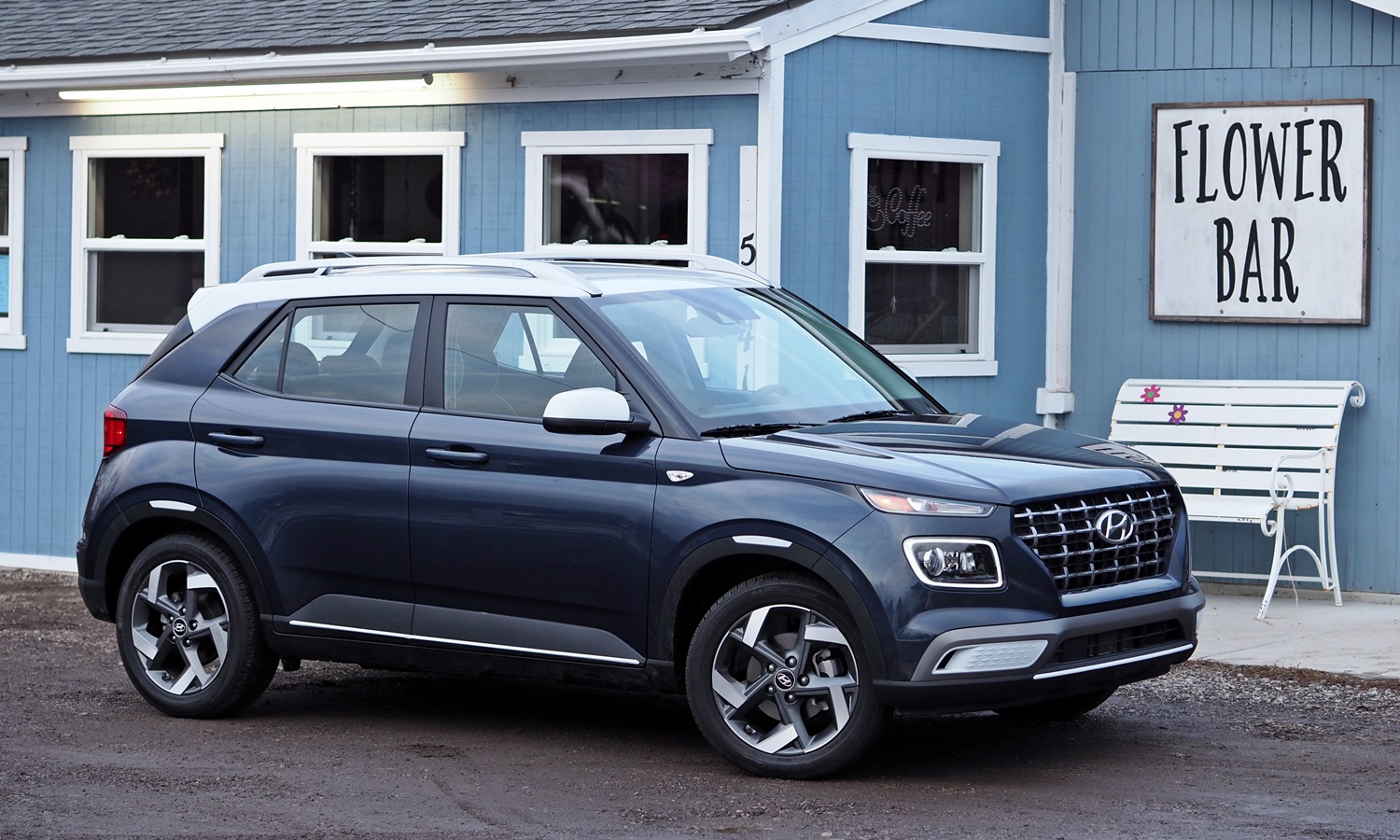
Sophisticated surfacing even on Hyundai's cheapest crossover. A lot going on, yet it all coheres. more Venue photos
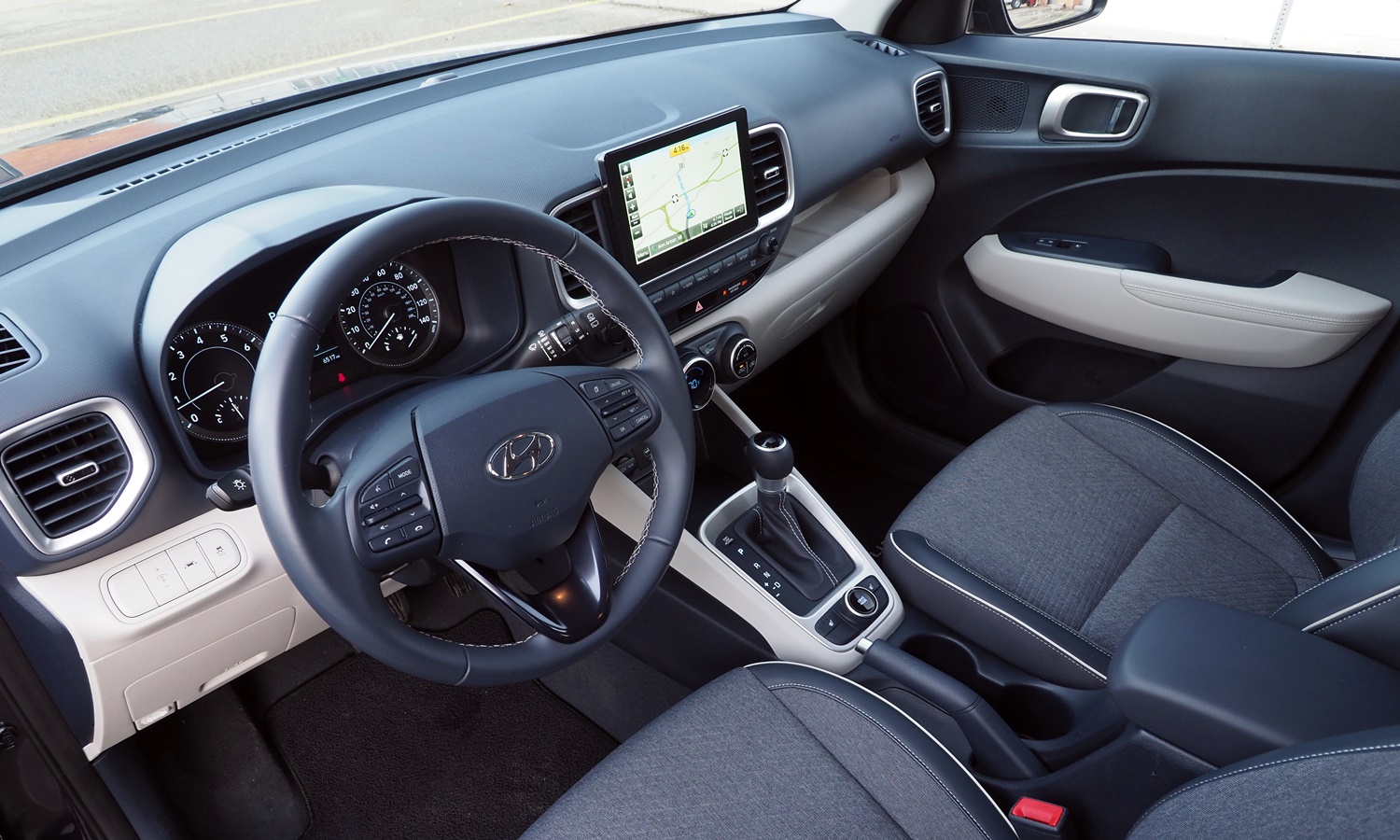
The blue and white theme continues inside the Denim. The entire interior, not just accents.
| |
Compared to the EcoSport |
| Price or payments |
 Better
Worse
Better
Worse
|
Pricing for the Hyundai Venue SE starts a smidge below $20,000, at $19,925. At the other end of the range, we have the SEL with Premium Package, which with floormats lists for $23,480. That $2,350 package includes LED lights front and rear, proximity key, heated seats, nav, and sunroof. The tested Venue Denim exchanges that sunroof for a distinctive appearance inside and out and a price lower by $100. A good trade? Eye of the beholder.
The larger (a half-foot longer on a quarter-foot more wheelbase) Kia Soul starts lower, but in $18,610 form has a manual transmission and no collision-warning and - avoidance systems. For 2021, Hyundai no longer offers the Venue with a manual transmission, so even the least expensive Venue now comes equipped with a CVT plus a full suite of safety tech (forward collision warning with automatic braking, lane departure warning and prevention, lane keep assist, blind spot warning, and rear cross-traffic warning with automatic braking). Opt for the CVT (bundled with cruise control and remote keyless entry) on the Soul LX, and its MSRP jumps $1,500, landing a couple hundred dollars above the base Venue's. Step up to the Soul S to match the Venue's safety tech, and the Kia's MSRP climbs to $21,710. If you want a small crossover these features--and they're an especially good idea for young drivers--then the Venue is the least expensive option.
Moving farther up the lines, compare the mid-level Venue SEL to the Soul S for feature parity, and the Hyundai lists for $735 less. Step up another level to compare the SEL with Premium Package to the Soul EX, and the Hyundai lists for $1,145 less.
But is the box-on-wheels Kia even really a crossover? We classify the Soul as a hatchback, albeit a tall one (at 63 inches, 1.4 inches taller than the Venue). What's the difference? Although the Venue rides no higher off the road, it looks more like a crossover.
Among crossovers sized closer to the Venue, the Nissan Kicks starts $670 higher. The Ford EcoSport starts $1,315 higher even though the Venue includes about $500 in additional standard equipment. Load both vehicles up, and the Hyundai's advantage widens to about $2,200 before adjusting for feature differences and about $2,750 afterwards--large sums at this price level. The Honda CR-V and Toyota C-HR start over $22,000.
And the next rung up Hyundai's ladder? A Kona costs about $1,000 more after adjusting for feature differences. And the larger, roomier Kia Seltos? It lists for $3,185 more before adjusting for feature differences, and about $1,400 more afterwards. Complicating this last comparison: you cannot get AWD on the Venue, but it's standard on the lowest trim level of the Seltos. To get a front-drive Seltos you must get the second trim level.
| Warranty, maintenance cost |
 Better
Worse
Better
Worse
|
A long standard warranty--5 years and 60,000 miles on nearly the entire vehicles and, for the first owner, 10/100 on the powertrain--further guarantees that the Hyundai Venue will be inexpensive to own. Other Hyundais and Kias include the same warranty, but the non-Korean competition does not.
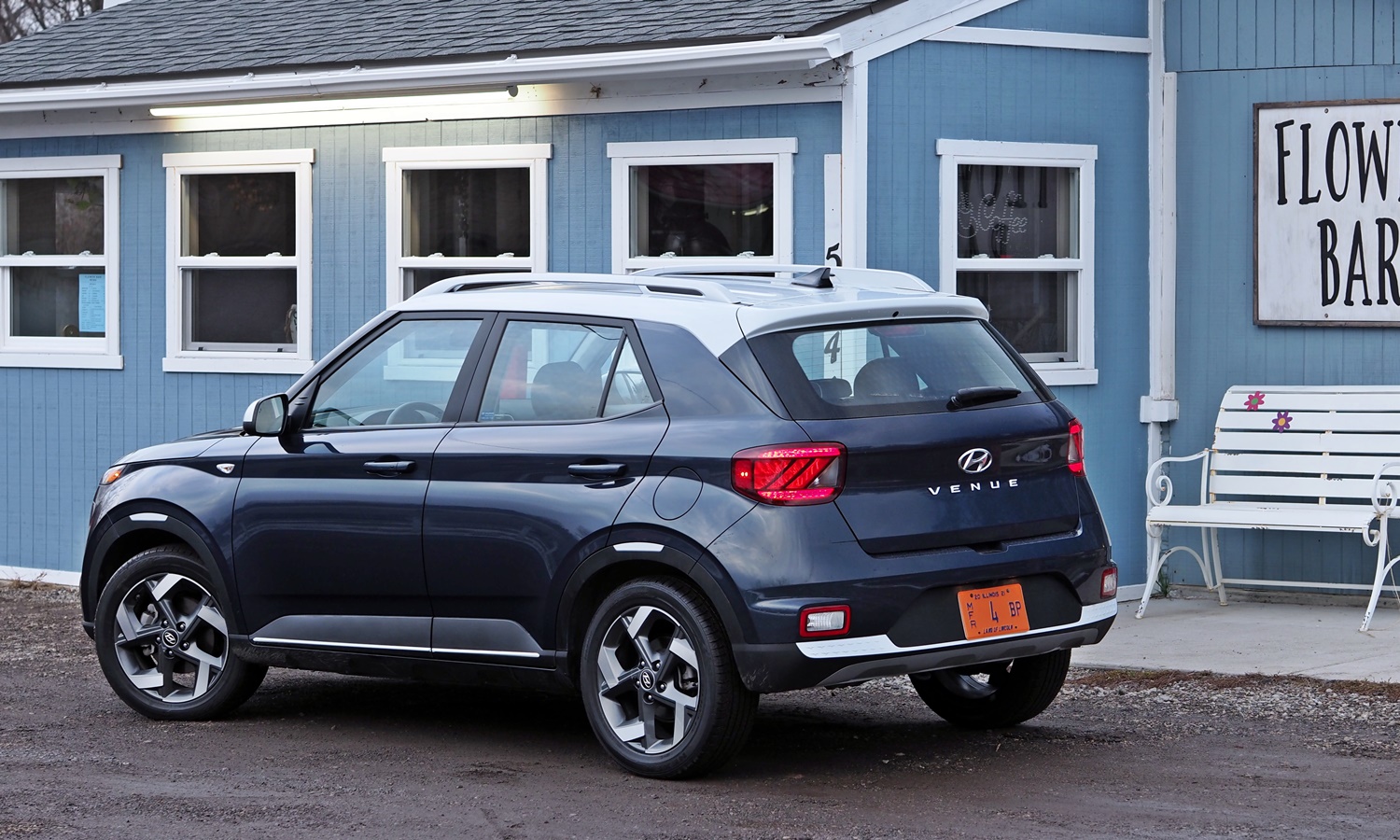
Styling makes the rear pillar appear much less upright than it actually is. LED tail lights.
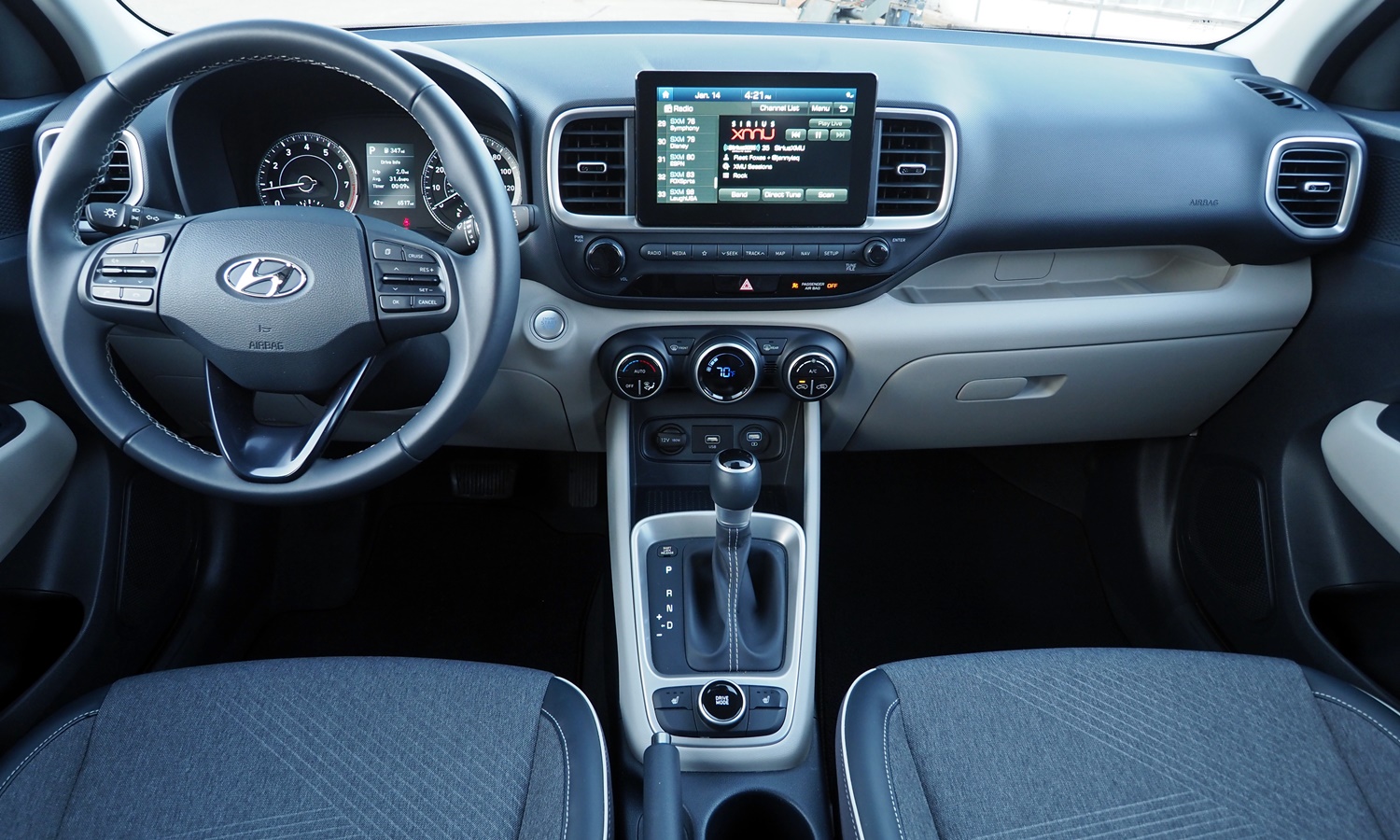
All hard plastic, but it doesn't look cheap. Compact instrument panel puts everything in easy reach
| Exterior styling |
 Better
Worse
Better
Worse
|
Hyundai has hired some top design talent in recent years, and it shows in the Venue's artful sculpting (there's a lot going on, yet it forms a coherent whole) and pleasing proportions (harder to achieve on a vehicle this small). As is often the case, the base trim level's relatively small wheels, 15 inches in diameter, weren't part of the designer's vision. (Though they are alloy, unlike the wheels on the base Kia Soul.) The 17-inch wheels of the SEL and Denim trim levels much better fill the openings within the Venue's athletically flared fenders, for a sportier and more upscaler appearance.
For a Venue that doesn't look like just another small crossover, though, you want the Denim. This trim level sets off a distinctive blue exterior with white on the roof, mirrors, fascias, and wheel openings. With these, the Venue goes from quietly handsome to stylish, and clearly not just basic transportation.
I personally find the Ford EcoSport much less attractive.
| Interior styling |
 Better
Worse
Better
Worse
|
The Venue Denim's interior similarly avoids a generic appearance. Unusual for a class where gray and beige tend to be the only interior color choices, nearly all of the Denim's interior surfaces are either dark blue or a high-contrast off-white. The seat fabric itself has the appearance of denim, hence Denim.
Virtually every surface save the seats, armrests, and steering wheel is hard to the touch, but this is typical of the class. Though these surfaces don't feel luxurious, they don't appear cheap. The interior of the Ford EcoSport has some much sketchier bits.
My primary quibble with the Venue's interior design involves the infotainment display. Like many it looks like a tablet has been attached to the instrument panel as an afterthought. This can enable the display to be closer to eye level without making the entire instrument panel taller. But in this case the display only sticks up a fraction of an inch, so why have it stick up at all?
| |
Compared to the EcoSport |
| Rear seat room & comfort |
 Better
Worse
Better
Worse
|
The Venue has a very small exterior compared to nearly every other North American market crossover, and Hyundai's packaging engineers performed no miracles. While the rear seat is high enough to provide thigh support and is comfortable, and headroom is plentiful, rear knee room is not.
The Kia Soul and Seltos both offer more than four inches of additional rear legroom, a large difference. The Ford EcoSport offers two more inches. But the Hyundai Kona's rear seat is about as tight as the Venue's.
| Cargo capacity |
 Better
Worse
Better
Worse
|
The Hyundai Venue also cannot hold nearly as much cargo as even the average small crossover. Even the Kona and the Ford EcoSport can hold about 50 percent more stuff when their rear seats are folded (but only about the same when they're not). A Kia Soul or Seltos has nearly twice the cargo volume.
But hold on a minute. My tape measure tells a somewhat different story. The cargo areas in the Venue and Seltos are about the same width and height, and they don't vary tremendously in length. With the second row up the cargo area in about six inches longer, 32 vs. 26 inches. With the seat folded the Kia's advantage grows to about eight inches, 64 vs. 56. How does a 14% longer floor translate to nearly double the volume? I suspect different methods of measurement. Has Hyundai sandbagged its own car?
At any rate, you might not need more cargo capacity than the Venue provides. Plus the Hyundai's cargo floor (like those in the Seltos and some Souls) can be set low for maximum volume or raised a few inches to make it level with the backs of the folded seats.
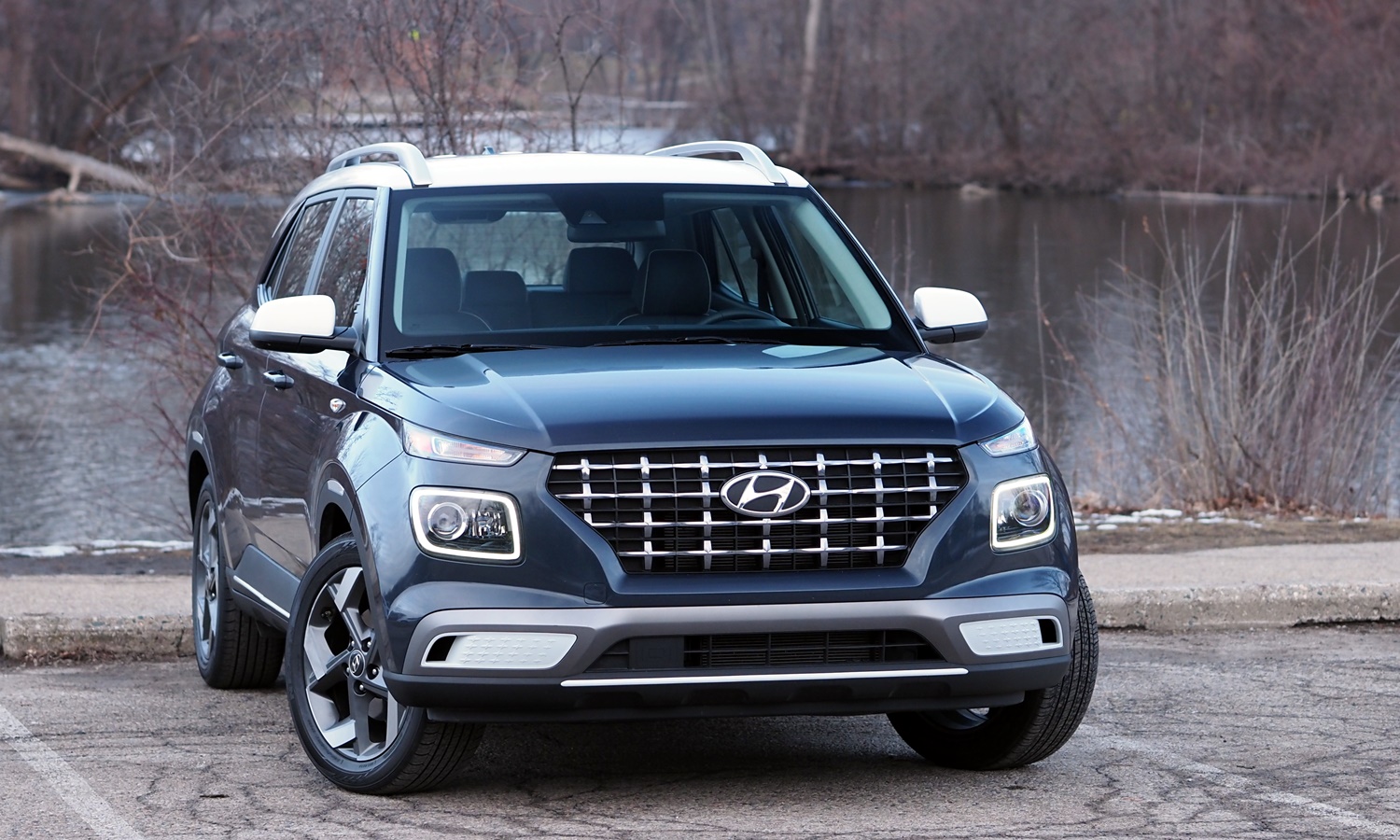
As with the Jeep Cherokee that pioneered this look, the primary headlights look like fog lights.
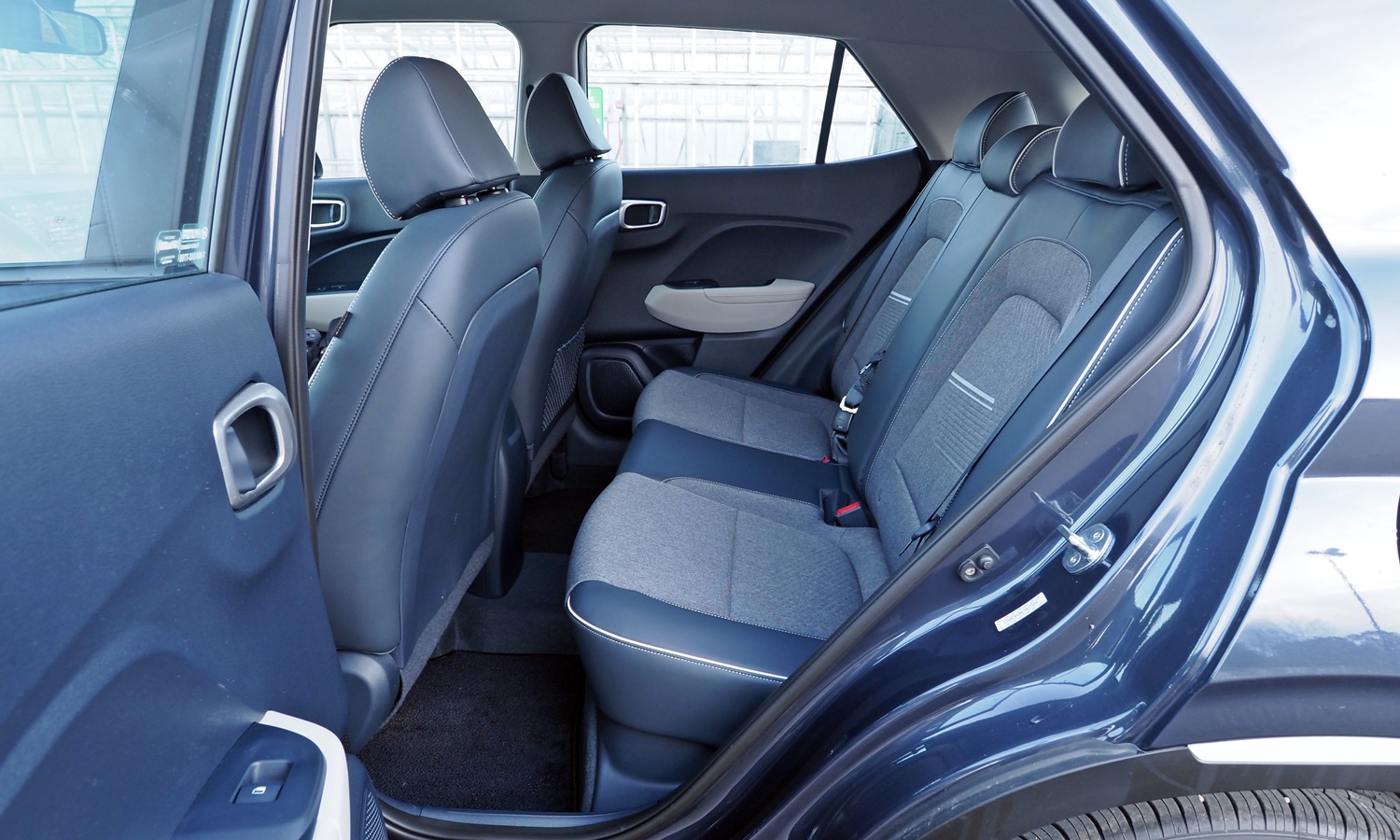
Good seat position and shape, plus plenty of headroom, but limited kneeroom.
| Feature availability |
 Better
Worse
Better
Worse
|
Like the Kia Soul, Nissan Kicks, and Toyota C-HR, but unlike its other competitors, the Venue cannot be equipped with AWD.
Also, while much collision avoidance tech is standard on even the least expensive Venue, you cannot get adaptive cruise (which uses many of the same sensors), leather seating surfaces, a heated steering wheel, or a power driver seat.
The Ford EcoSport offers less avoidance tech but more luxury features. I've rated this a wash, though many people will care for one set of features more than the other.
| |
Compared to the EcoSport |
| Powertrain performance |
 Better
Worse
Better
Worse
|
With its 1.6-liter engine's 121 horsepower and 4,500 rpm torque peak, the Hyundai Venue could feel hopelessly sluggish. Yet it doesn't. The CVT's wide ratio spread likely helps. A curb weight about a quarter-ton less than those of the EcoSport and Seltos definitely does. Getting from a stop to 60 mph takes about nine seconds. Somehow the Nissan Kicks takes nearly two more seconds to do the deed even though the two vehicle have similar engine outputs and curb weights. The heavier Ford EcoSport and Toyota C-HR are about as sluggish as the Kicks. Among direct competitors, only the Mazda CX-3 is quicker than the Venue. How to explain the Hyundai's relative quickness in this crowd? I don't know.
Only at highway speeds does the Venue's performance become tepid. If you want thrilling acceleration or strong passing power, you need a larger crossover. The Hyundai Kona and Kia Seltos each offer a 175-horsepower turbocharged 1.6-liter engine.
Since they were invented, CVTs have tended to feel wrong because they can and often do hold engine speed steady even as vehicle speed increases, such that the engine noise suggests a slipping transmission. Hyundai has successfully avoided this sensation by programming its latest CVT to behave much like a conventional stepped transmission in most situations. An engine that produces far fewer objectionable noises than those Honda installs in the Fit and HR-V, and so seems less strained, helps.
If you want to force the Venue's CVT to behave like a regular automatic slide the shifter sideways into sport mode then manually shift it. This can also be done to derive slight firmer steering via sport mode without making the CVT's behavior more frenetic. Otherwise sport mode steering entails an over-eager sport mode transmission.
| Fuel economy |
 Better
Worse
Better
Worse
|
In the EPA's tests the Hyundai Venue earned ratings of 30 mpg city and 34 mpg highway. The Ford EcoSport scored significantly worse, 27 / 29, but the Nissan Kicks does a but better, 31 / 36. With their heavier curb weights and larger engines, the Kona, Soul, and Seltos score an mpg or three lower than the Venue in city driving but about the same or even a little better in highway driving.
Driving the Venue, I observed about 33 mpg in both suburban and highway driving. On a 55-mph two-lane with infrequent stops, close to a best-case scenario, the Venue achieved a two-way average of 37 mpg.
The Hyundai Venue handles predictably, with no feeling of tippiness despite being a few inches taller than a conventional car. But the small crossover never feels sporty. The steering is a bit light for my taste, and sport mode firms it up so little I could barely detect a difference. Still, I found the Venue fairly fun to drive owing to its small size and moderately firm suspension tuning.
| Driving position & visibility |
|
With the driver seat in its lowest position I felt a bit buried. Luckily even the least expensive Venue has a height-adjustable driver seat, and a pull or two on the lever fixed this. The seat itself, though its lumbar support cannot be adjusted, felt comfortable to me on a multi-hour drive. Though the Venue's suspension is firm enough to effectively control body motions and its wheelbase is under 100 inches, the ride doesn't feel harsh or choppy on even poorly maintained roads.
Noise levels are moderate around town and higher but far from uncomfortable at highway speeds. In general the Hyundai Venue comes across as refined rather than cheap.
The key takeaway here: the Hyundai Venue, especially in Denim form, does not look or feel like a cheap car or even like basic transportation. A solid vehicle that performs well in typical daily driving, it even possesses some character visually. It's not "just another generic small car."
That said, the Venue is small, and some people will need a larger rear seat, more cargo capacity, or both. Other potential buyers might wish for a stronger engine. For these, the Hyundai Kona, Kia Seltos, or Mazda CX-30 (which is much more expensive) should be better alternatives.
But anyone looking for the least expensive crossover with comprehensive collision-avoidance features and who doesn't need more room or more power will likely be pleasantly surprised by how the Venue looks and drives. It is small. And it is inexpensive. But it's no penalty box.
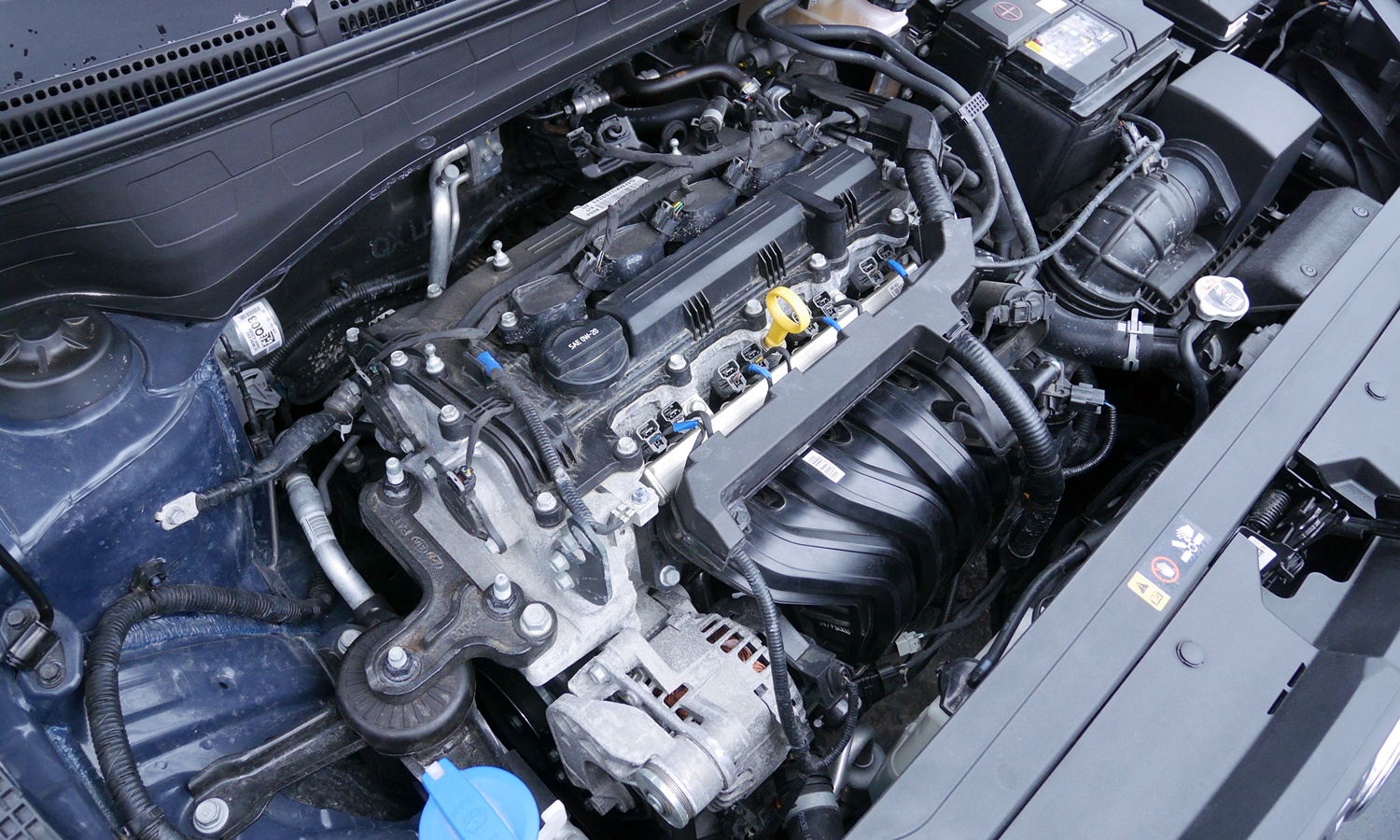
The 121-horsepower 1.6-liter four has a port fuel injector for each intake valve, for a total of 8.
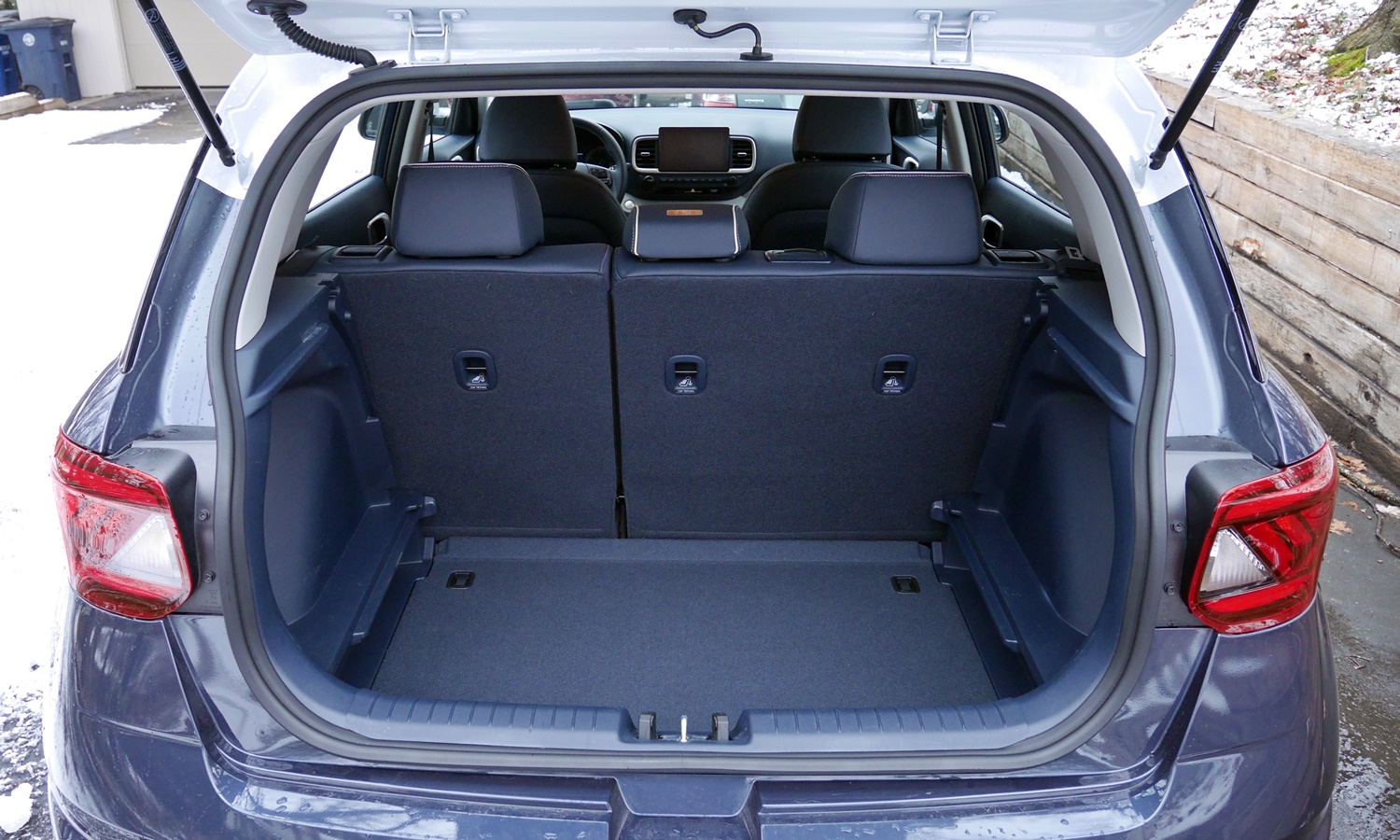
Not much cargo volume behind the second row, but usually enough. Floor in lower of two positions.
See more 2020 Hyundai Venue photos
Hyundai provided an insured car with a tank of fuel for a week.











